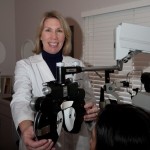Shorter days and rainy weather, both contribute to difficulty driving. A driver’s vision guides 90% of driving decisions, so good eyesight is essential for road safety.

Start with an eye examination to assess clarity, peripheral vision and eye disease. Having the proper vision skills and prescription are important for many reasons:
Distance vision is imperative for judging distances and reaction time when driving. Poor distance vision increases the risk of making unreliable judgments with potentially disastrous results – even the simplest reactions take 0.4 seconds, so if distance vision is poor, signs or objects may not be seen until it is too late to react safely.
Good Peripheral Vision allows drivers to survey the area without looking away from the road. This includes early recognition of cross-traffic, pedestrians, animals, signs and changes in traffic flow. Impaired peripheral vision can result in the driver failing to react to a hazard on the far left or right, failing to stop at a stoplight suspended over an intersection, weaving while negotiating a curve, or driving too close to parked cars.
Safe Night Driving requires the ability to see in low light conditions and with poor contrast. Impaired night vision can result in tailgating, failing to steer when necessary (since it is difficult to see low contrast features such as edges or irregularities in the road surface), and recover from glare of oncoming headlights.
Glare refers to the disruption of vision due to veiling luminance. Important visual skills for drivers are glare resistance – the extent to which the driver can still see critical objects while facing a steady source of glare (setting sun, headlights), and glare recovery – the rapidity with which the driver’s functioning vision returns to what it was before the glare was encountered. If these skills are not adequate, the driver can miss curves, strike an animal or pedestrian or crash into slow moving or stopped vehicles.
Besides regular eye exams, additional tips for good vision while driving include:
- Always wear sunglasses when driving to reduce glare
- Keep headlights, tail lights , windshields and eye glasses clean
- Keep side and rear view mirrors adjusted correctly to increase your field of vision and reduce glare from headlights
- Always wear glasses or contact lenses if they have been prescribed for driving


